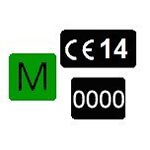The conformity of scales is indicated by the markings
Scales used in commerce must comply with the requirements of the NAWI Directive. Automatic scales must comply with the requirements of the Measuring Instruments Directive. The manufacturer’s declaration of conformity must be provided with the scales.
The weighing area and durability of the scales must be suitable for their intended purpose and operating environment. When purchasing scales, take issues such as the temperature range, accuracy class and minimum and maximum weighing area of the scales into account. The information can be found on the type plate of the scales.
New scales that conform to the requirements have the marking shown in Figure 1. An incomplete marking (the number of the notified body is missing, for example) means that the scales are not compliant with the requirements; such scales cannot be used.

Figure 1. Set of markings indicating the conformity of scales.
Old non-automatic scales that are in use may have a marking shown in Figure 2. Scales older than this that are still in use may have the old Finnish VJ type approval mark. Such old scales can still be used if they are in working order and have been duly verified during their period of service.

Figure 2. Marking indicating the conformity of non-automatic scales (scales commissioned from 1990 to 20 April 2016)
The scales must be suitable for the purpose
If the scales are not suitable for the purpose, they are not compliant with the requirements of the Finnish Measuring Instruments Act, even if they did comply with the requirements of the directives and had the marks indicating conformity. When choosing scales, make sure that their weighing area, accuracy class and operating temperature are suitable for the purpose. If you use the scales in consumer sales, also make sure that the display of the scales and the information shown there comply with the special requirements on scales suitable for consumer sales.
Accuracy classes of scales
In retail, use scales that are at least in accuracy class III. In the sale of precious metals and gemstones, use scales that are at least in accuracy class II.
Legislation
Measuring Instruments Act 707/2011
Government Decree on Measuring Instruments 471/2014
Government Decree on Non-Automatic Scales 1431/2016
Government Decree on Essential Requirements, Demonstration of Compliance and Specific Technical Requirements of Measuring Instruments 1432/2016
Measuring Instruments Directive 2014/32/EU (MID)
Non-Automatic Weighing Instruments Directive 2014/31/EU (NAWID)
Council Directive 76/211/EEC on the approximation of the laws of the Member States relating to the making-up by weight or by volume of certain prepackaged products
Council Directive 75/107/EEC on the approximation of the laws of the Member States relating to bottles used as measuring containers
Council Directive 80/181/EEC on the approximation of the laws of the Member States relating to units of measurement
Directive 2009/34/EC relating to common provisions for both measuring instruments and methods of metrological control